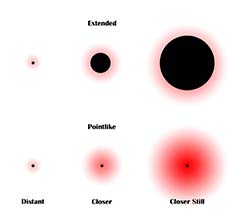What's the point?
 |
If you magnify an extended particle, it will look bigger. A point-like particle will not change in size, but the more closely you look at it, the stronger the field surrounding it.
|
Read the complete column on point-like particles.
The field of particle physics is full of what can be confusing dichotomies: fermion vs. boson, hadron vs. lepton, paper vs. plastic (okay, not that last one). You can add yet another to the list: extended particles vs. point-like particles.
The quarks, leptons and bosons of the Standard Model are point-like particles. Every other subatomic particle you’ve heard of is an extended particle. The most familiar are the protons and neutrons that make up the nucleus of an atom, but there are many others—pions, kaons, Lambda particles, omegas and lots more. The defining feature of these kinds of particles is that they have a reasonably measurable size (which happens to be about the size of a proton).
Now extended particles don’t have a well-defined surface like a marble does. They’re a bit more like the Earth and its atmosphere. The atmosphere of the Earth is thickest near the surface of the Earth and it gets thinner with altitude. So the exact point at which you can say that you are no longer in the Earth’s atmosphere is a bit fuzzy, but you can still safely say that the boundary between inside and outside the Earth’s atmosphere is 10 or 20 miles straight up. Independent of the exact point at which you say something is inside or outside, extended particles have a size.
Point particles are much more bizarre and are sometimes said to have zero size. This statement has raised more than one eyebrow. How can something have no size at all? And if it has mass, does the zero size mean it has infinite density? (And by the way, as you read on, you’ll see the answer to that last one is no.) You begin to see why some people are skeptical when a scientist says a particle is point-like.
Yet there is a sense in which it’s true. So how can that be?
Read more
—Don Lincoln
Want a phrase defined? Have a question? E-mail today@fnal.gov.
|